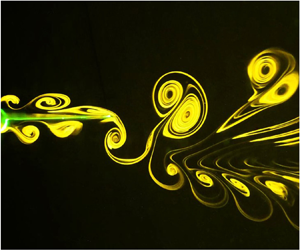Crossref Citations
This article has been cited by the following publications. This list is generated based on data provided by
Crossref.
Bhattacharyya, Soumarup
Khan, Izhar Hussain
Verma, Shivam
Kumar, Sanjay
and
Poddar, Kamal
2022.
Experimental investigation of three-dimensional modes in the wake of a rotationally oscillating cylinder.
Journal of Fluid Mechanics,
Vol. 950,
Issue. ,
Jenkins, Michael
Suresh Babu, Arun Vishnu
Bryant, Matthew
and
Gopalarathnam, Ashok
2022.
A Computational Study of Vortical Wakes behind Oscillating Cylinder-Splitter-Plate Gust Generators.
Mao, Qian
Zhao, Jiazhen
Liu, Yingzheng
and
Sung, Hyung Jin
2022.
Drag reduction by a rotationally oscillating cylinder with a flexible filament.
Physics of Fluids,
Vol. 34,
Issue. 4,
Sun, Yuehao
Peng, Ze-Rui
Yang, Dan
Xiong, Yongliang
Wang, Lei
and
Wang, Lin
2022.
Dynamics of a rigid-flexible coupling system in a uniform flow.
Journal of Fluid Mechanics,
Vol. 943,
Issue. ,
Afra, B.
Delouei, A. Amiri
and
Tarokh, A.
2022.
Flow-Induced Locomotion of a Flexible Filament in the Wake of a Cylinder in Non-Newtonian Flows.
International Journal of Mechanical Sciences,
Vol. 234,
Issue. ,
p.
107693.
Mao, Qian
Liu, Yingzheng
and
Sung, Hyung Jin
2022.
Drag reduction by flapping a flexible filament behind a stationary cylinder.
Physics of Fluids,
Vol. 34,
Issue. 8,
Sunil, Puja
Kumar, Sanjay
and
Poddar, Kamal
2023.
Effect of filament length on the flow field of a rotationally oscillating cylinder with an attached filament.
Physics of Fluids,
Vol. 35,
Issue. 12,
Bhattacharyya, Soumarup
Hussain Khan, Izhar
Sunil, Puja
Kumar, Sanjay
and
Poddar, Kamal
2023.
Experimental investigation of flow past a rotationally oscillating tapered cylinder.
Physical Review Fluids,
Vol. 8,
Issue. 5,
Zhang, Huanyu
Zhao, Yakun
Tian, Xinliang
Wang, Xiaolong
and
Liu, Hao
2023.
Symmetry breaking of a closed flexible filament behind a rigid plate at low Reynolds numbers.
Physics of Fluids,
Vol. 35,
Issue. 2,
Khan, Izhar Hussain
Sunil, Puja
Bhattacharyya, Soumarup
Yadav, Rahul
Poddar, Kamal
and
Kumar, Sanjay
2023.
Flow past two rotationally oscillating cylinders.
Journal of Fluid Mechanics,
Vol. 969,
Issue. ,
Yawar, Arsalan
Salehi, Fatemeh
and
Manzoor, Shehryar
2023.
Lock-on to quasi-periodic flow transformation for a rotationally oscillating cylinder due to gust impulse.
Physics of Fluids,
Vol. 35,
Issue. 7,
Sharma, Vikas
and
Dutta, Sushanta
2023.
Effect on drag–thrust transition for flapping airfoil with chordwise flexibility.
Physics of Fluids,
Vol. 35,
Issue. 7,
Zhang, Huanyu
Zhao, Yakun
Tian, Xinliang
and
Liu, Hao
2023.
Effects of the closed domain area on the dynamics of a closed flexible filament behind a rigid plate.
Ocean Engineering,
Vol. 288,
Issue. ,
p.
115944.
Bhattacharyya, Soumarup
Naidu S, Raghavendra
Poddar, Kamal
and
Kumar, Sanjay
2023.
Flow past a rotationally oscillating cylinder near a plane wall.
Physical Review Fluids,
Vol. 8,
Issue. 9,
Jenkins, Michael
Suresh Babu, Arun Vishnu
Bryant, Matthew
and
Gopalarathnam, Ashok
2023.
Numerical Study of Circular-Cylinder Disturbance Generators with Rigid Splitter Plates.
AIAA Journal,
Vol. 61,
Issue. 12,
p.
5470.
Mao, Qian
Liu, Yingzheng
and
Sung, Hyung Jin
2023.
Drag reduction by flapping a pair of flexible filaments behind a cylinder.
Physics of Fluids,
Vol. 35,
Issue. 3,
Sharma, Vikas
and
Dutta, Sushanta
2024.
EFFECT OF BIO-INSPIRED MODIFICATION ON FLUID-STRUCTURE INTERACTION AND ITS CONTROL: A REVIEW
.
Journal of Flow Visualization and Image Processing,
Vol. 31,
Issue. 4,
p.
15.
Kumar, Dhiraj
Poddar, Kamal
and
Kumar, Sanjay
2024.
The effect of aspect ratio and mass ratio on the flow-induced flutter of a thin flexible sheet.
Physics of Fluids,
Vol. 36,
Issue. 11,
Xiong, Zhongying
Xia, Huan
and
Han, Tao
2024.
Effects of fish body thickness on hydrodynamic performance for self-propulsion carangiform swimmer.
Physics of Fluids,
Vol. 36,
Issue. 8,
Liu, Kui
and
Huang, Haibo
2024.
Dynamics of weighted flexible ribbons in a uniform flow.
Journal of Fluid Mechanics,
Vol. 990,
Issue. ,

 $St_{A} \sim 0.25\text {--}0.5$, encountered in nature in flapping flight/fish locomotion and in the flow past pitching airfoils. The transition from a Kármán vortex street to a reverse Kármán vortex street precedes the drag-to-thrust transition. The mechanism of unsteady thrust generation is discussed. Maximum thrust is generated at the instants when vortices are shed in the wake from the filament tip. At
$St_{A} \sim 0.25\text {--}0.5$, encountered in nature in flapping flight/fish locomotion and in the flow past pitching airfoils. The transition from a Kármán vortex street to a reverse Kármán vortex street precedes the drag-to-thrust transition. The mechanism of unsteady thrust generation is discussed. Maximum thrust is generated at the instants when vortices are shed in the wake from the filament tip. At  $St_{A} > 0.4$, a deflected wake associated with the shedding of an asymmetric vortex street is observed. Filament flexibility delays the formation of an asymmetric wake. Wake symmetry is governed by the time instant at which a vortex pair is shed in the wake from the filament tip.
$St_{A} > 0.4$, a deflected wake associated with the shedding of an asymmetric vortex street is observed. Filament flexibility delays the formation of an asymmetric wake. Wake symmetry is governed by the time instant at which a vortex pair is shed in the wake from the filament tip.